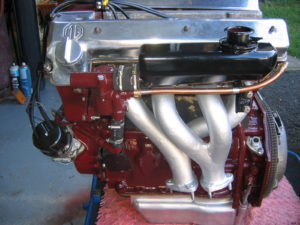60 Years Young- The MGA Twin Cam. Some thought after the event.
2018 saw the 60th Anniversary of the launch announcement of the MGA Twin Cam on 15th July 1958. The previous day, 14th July, MG had organised a Press demonstration day at Chobham complete with the Morris Works band and EX181, itself powered by a supercharged Twin Cam engine.
Somewhat surprisingly both events passed without John Thornley being in the country. He had decided to undertake a tour of US dealers and MGCC branches. It would be disingenuous to suggest that this trip was in any way connected to his 25th Wedding Anniversary, which also fell on 15th July. Contemporary reports in ‘Motoring’, which included MGCC information prior to the publication of Safety Fast! show him travelling widely in the US, although whether he made the scheduled announcement of the Twin Cam at the MGCC New York on the 15th July was not reported. At the same dinner, he should have received a glass Loving Cup inscribed with an Octagon on one side and an owl, Mrs Thornley’s favourite animal, on the other. This was shipped out to the US by Geoffrey Iley, Mr Thornley’s Assistant General Manager, from Abingdon.
The exact genesis of the MGA Twin Cam will never be known. That it was the brainchild of John Thornley, Sid Enever and Alex Hounslow is not in doubt. The MGA was a revolutionary concept for MG following the string of traditional two-seater sports cars starting before World War II with the MG TA and culminating in the MG TF, a car clearly behind the times in design terms even before it was produced. MG’s 1955 Le Mans entries were clearly MGAs in all but name and it is apparent that the development of Twin Cam engines, of both separate Austin and Morris design, must have been commenced prior to the MG’s 1955 Dundrod entry in which they featured.
Development of the MGA Twin Cam by MG can be tracked by entries in the EX register devoted solely to the Twin Cam. It is, thus, clear that the Twin Cam must have been envisaged as a possible variant of the pre-production MGA, at least in concept, at about the same time as the MGA project itself was being progressed.
Car manufacturers develop many concept cars nowadays but in the 1950s, resources, especially at MG, were stretched so the continued development of the Twin Cam following the Nuffield Organisation’s withdrawal from circuit racing after the tragedies of the 1955 Le Mans and Dundrod must have relied on the ongoing support of Thornley et al.
Having developed the car and even having produced the pre-production prototype YD1/499, what persuaded MG to put the car into production? Several factors have been cited including the pressure coming from US dealers for the MGA to have more horsepower. The US was MG’s principal market, and this puts John Thornley’s presence in New York on 15th July 1958 into context.
The extent to which the desire by MG management to have a car capable of making credible competition entries will never be known but it may well have been a factor in proceeding to production, whereas the potential for a direct economic benefit, based on the premium over the standard car and the likely added production cost, is difficulty to justify, especially with hindsight.
This is the more so as production was said to be designed to be limited and that the Twin Cam would only end up in the hands of enthusiasts. If this was really the strategy then it was naïve to say the least, because the moment demand for the car became apparent it was inevitable that the marketeers and ‘bean counters’ would take over and push for production increases, which is exactly what happened.
However, there are grounds to believe that MG knew that the engine was delicate in certain circumstances and that the professed self-imposed limit on production and distribution was a way of both addressing this weakness and validating a decision to proceed to production.
In the event, of course, the engine proved unreliable in both the hands of the experienced racer and the youngsters. The result being that the reputation of not only the Twin Cam but also the MGA and indeed the MG brand itself all suffered because of the engine failures and warranty claims. This culminated in the 1960 cessation of production of the Twin Cam after just 2,111 had been produced – just over 2% of total MGA production. The demise of the Twin Cam received almost no publicity at the time, which speaks for itself. Now that the causes, and more importantly, the fixes are well known, the engine is ‘on song’.
All the above is well known and largely documented. Perhaps casting events in their historical context gives a better understanding of possibly why the car was developed and produced. Taken as a whole, there seems no overarching commercial or other rationale and ultimately perhaps Thornley, Enever and Hounslow made it happen simply because they could.
As MGA Twin Cam owners, we should be delighted they did!

